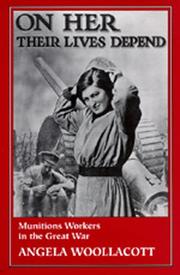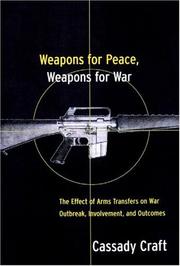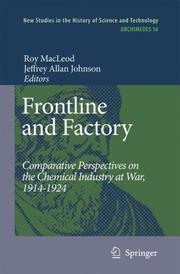| Listing 1 - 10 of 13 | << page >> |
Sort by
|
Book
ISBN: 1911116258 9781911116257 9781788210935 178821093X 9781911116233 9781911116240 191111624X 1911116231 Year: 2023 Publisher: Newcastle upon Tyne Agenda Publishing
Abstract | Keywords | Export | Availability | Bookmark
 Loading...
Loading...Choose an application
- Reference Manager
- EndNote
- RefWorks (Direct export to RefWorks)
An introduction to the economics of the arms industry by one of the world's top defence economists.
Weapons industry. --- Arms industry --- Military weapons industry --- Munitions --- Munitions industry --- Defense industries --- Weapons industry --- Economic aspects --- Military policy --- Economic aspects.
Book
ISBN: 2757422766 2859399917 Year: 2019 Publisher: Villeneuve d'Ascq : Presses universitaires du Septentrion,
Abstract | Keywords | Export | Availability | Bookmark
 Loading...
Loading...Choose an application
- Reference Manager
- EndNote
- RefWorks (Direct export to RefWorks)
De la boutique artisanale à l’atelier flexible, de la proto-industrie aux restructurations, les quatre siècles d’histoire des arsenaux de terre sont ceux des ingénieurs de l’Armement aux sources de la continuité de l’État et des « ouvriers de l’État » dont les privilèges, comme ceux de l’entrepreneur, redessinent l’Ancien Régime, et les statuts successifs les Empires et les Républiques, bref, les consensus nationaux. Les archives nationales et syndicales retracent l’élaboration de la rationalisation du travail ou du concept de « nationalisation » des programmes de gauche. Le syndicalisme naissant, le basculement vers le pacifisme des militants de 1918, l’engagement résistant de ceux de 1940, les révocations des années 1950, le pluralisme syndical de la fin du xxe siècle sont éclairés sous un nouveau jour. Étrange destin que celui d’hommes de paix travaillant pour la guerre ! Illustrissimes, l’on ignorait un peu de ce qu’ils furent : Danton, Thomas, Tillon, Gonin… Inconnus, ils sont parfois essentiels : Gervaise et Voilin, précurseurs de la CGT et de la gauche, les ingénieurs visionnaires Danzel ou Enjalbert… une multitude a contribué à façonner notre monde, militants des villes de manufacture et d’arsenal ou simples héritiers de dynasties ouvrières… Douze larges extraits de documents originaux dont 10 inédits, 32 illustrations, 24 graphiques et tableaux introduisent le lecteur dans cet univers qui n’est autre que le sien… et où la volonté politique l’emporte sur la fatalité, au rebours des idéologies dominantes.
Weapons industry --- Firearms industry and trade --- History. --- Employees --- Arms industry --- Military weapons industry --- Munitions --- Munitions industry --- Defense industries --- histoire --- État --- Grand Siècle --- armuriers --- globalisation

ISBN: 0585079471 0520914651 9780520914650 9780585079479 0520083970 0520085027 Year: 1994 Publisher: [Place of publication not identified] University of California Press
Abstract | Keywords | Export | Availability | Bookmark
 Loading...
Loading...Choose an application
- Reference Manager
- EndNote
- RefWorks (Direct export to RefWorks)
In this evocative book, Angela Woollacott analyzes oral histories, workers' writings, newspapers, official reports, and factory song lyrics to present an intimate view of women munitions workers in Britain during World War I.Munitions work offered working-class women—for the first time—independence, a reliable income, even an improved standard of living. But male employers and trade unionists brought them face-to-face with their subordination as women within their own class, while experiences with middle-class women co-workers and police reminded them of their status as working class.Woollacott sees the woman munitions worker as a powerful symbol of modernity who challenged the gender order through her patriotic work and challenged class differences through her increased spending power, mobility, and changing social behavior.
World War, 1914-1918 --- Weapons industry --- History & Archaeology --- History - General --- Arms industry --- Military weapons industry --- Munitions --- Munitions industry --- Defense industries --- Women --- Employees
Periodical
Abstract | Keywords | Export | Availability | Bookmark
 Loading...
Loading...Choose an application
- Reference Manager
- EndNote
- RefWorks (Direct export to RefWorks)
Weapons industry --- Firearms industry and trade --- Munitions --- Armes à feu --- Industrie --- Arms industry --- Military weapons industry --- Munitions industry --- Armes à feu --- Firearms industry and trade. --- Weapons industry. --- Defense industries --- Ammunition --- Armes --- Explosives --- Gunnery --- Projectiles --- Ammunition.
Book
ISBN: 0585164312 9780585164311 0809317753 9780809317752 Year: 1992 Publisher: Carbondale, Ill. Southern Illinois University Press
Abstract | Keywords | Export | Availability | Bookmark
 Loading...
Loading...Choose an application
- Reference Manager
- EndNote
- RefWorks (Direct export to RefWorks)
Chemical arms control. --- Chemical weapons --- Weapons industry --- Chemical arms control --- International Law --- Law, Politics & Government --- Treaties, International --- Arms industry --- Military weapons industry --- Munitions --- Munitions industry --- Defense industries --- Weapons of mass destruction --- Chemical weapons control --- Arms control --- Political aspects
Book
ISBN: 0300125240 9786612351648 1282351648 0300151705 9780300151701 9781282351646 9780300125245 Year: 2008 Publisher: New Haven [Conn.] Yale Univ. Press
Abstract | Keywords | Export | Availability | Bookmark
 Loading...
Loading...Choose an application
- Reference Manager
- EndNote
- RefWorks (Direct export to RefWorks)
For this book a distinguished team of economists and historians-R. W. Davies, Paul R. Gregory, Andrei Markevich, Mikhail Mukhin, Andrei Sokolov, and Mark Harrison-scoured formerly closed Soviet archives to discover how Stalin used rubles to make guns. Focusing on various aspects of the defense industry, a top-secret branch of the Soviet economy, the volume's contributors uncover new information on the inner workings of Stalin's dictatorship, military and economic planning, and the industrial organization of the Soviet economy. Previously unknown details about Stalin's command system come to light, as do fascinating insights into the relations between Soviet public and private interests. The authors show that defense was at the core of Stalin's system of rule; single-minded management of the defense sector helped him keep his grip on power.
Defense industries -- Soviet Union. --- Soviet Union -- History -- 1925-1953. --- Soviet Union -- Military policy. --- Weapons industry -- Soviet Union. --- Defense industries --- Weapons industry --- Business & Economics --- Industries --- Soviet Union --- Military policy. --- History --- Arms industry --- Military weapons industry --- Munitions --- Munitions industry --- Defense industries -- Soviet Union.. --- Weapons industry -- Soviet Union.. --- Soviet Union -- Military policy..

ISBN: 1135961530 1135961549 042923998X 1280407174 0203902106 9786610407170 9780203902103 9780415922586 0415922585 9780415922593 0415922593 9781280407178 6610407177 9781135961541 9781135961497 9781135961534 Year: 1999 Publisher: New York : Routledge,
Abstract | Keywords | Export | Availability | Bookmark
 Loading...
Loading...Choose an application
- Reference Manager
- EndNote
- RefWorks (Direct export to RefWorks)
Using innovative techniques, this book has the potential to change the way analysts weigh the impact of weapons sales.
Arms transfers. --- War. --- Weapons industry. --- Arms industry --- Military weapons industry --- Munitions --- Munitions industry --- Defense industries --- Armed conflict (War) --- Conflict, Armed (War) --- Fighting --- Hostilities --- Wars --- International relations --- Military art and science --- Peace --- Arms sales --- Arms traffic --- Foreign military sales --- Military sales --- Sale of military equipment --- International trade --- Arms race --- Military assistance
Book
ISBN: 9783869451688 3869451688 3869451688 Year: 2009 Publisher: Nordhausen : Bautz,
Abstract | Keywords | Export | Availability | Bookmark
 Loading...
Loading...Choose an application
- Reference Manager
- EndNote
- RefWorks (Direct export to RefWorks)
1 EINLEITUNG 1.1 Relevanz des Gegenstands 1.2 Erkenntnisleitende Fragestellung 1.3 Eingrenzung des Themas 1.4 Literatur und Forschungsstand 1.4.1 Literatur zur deutschen ""Stickstofffrage"" 1.4.2 Literatur zur Rolle der Schweiz 1.4.3 Fazit Forschungsstand 1.5 Quellenlage 1.5.1 Literatur mit Quellencharakter 1.5.2 Gedruckte Quellen 1.5.3 Ungedruckte Quellen 1.6 Aufbau der Arbeit 2 DIE ""STICKSTOFFFRAGE"" IM EIGENTLICHEN SINNE 2.1 Grundlagen 2.1.1 Die Verfügbarkeit über Stickstoffverbindungen als Voraussetzung pflanzlichen und tier
World War, 1914-1918 --- Weapons industry --- Explosives, Military --- Neutrality --- Military explosives --- Explosives --- Arms industry --- Military weapons industry --- Munitions --- Munitions industry --- Defense industries --- European War, 1914-1918 --- First World War, 1914-1918 --- Great War, 1914-1918 --- World War 1, 1914-1918 --- World War I, 1914-1918 --- World War One, 1914-1918 --- WW I (World War, 1914-1918) --- WWI (World War, 1914-1918) --- History, Modern --- History. --- History

ISBN: 1280865431 9786610865437 1402054904 1402054890 Year: 2006 Publisher: Dordrecht : Springer,
Abstract | Keywords | Export | Availability | Bookmark
 Loading...
Loading...Choose an application
- Reference Manager
- EndNote
- RefWorks (Direct export to RefWorks)
The First World War is often called the ‘chemists’ war’. But few realise precisely how, or the extent to which modern chemistry became a significant factor in the struggle, and would be in turn deeply shaped by it. Gathering momentum at first, by 1916, success in applying scientific knowledge to ‘frontline and factory’ became a measure of a nation’s capacity to win an industrial war. In the end, the titanic contest was won in large part through the command of raw materials and industrial output. This book represents a first considered attempt to study the factors that conditioned industrial chemistry for war in1914-18. Taking a comparative perspective, it reflects on the experience of France, Germany, Austria, Russia, Britain, Italy and Russia, and points to significant similarities and differences. It looks at changing patterns in the organisation of industry, and at the emerging symbiosis between science, industry and the military, which contributed to the first ‘academic-military-industrial’ complex of the 20th century. At the same time, it reflects on the world’s first, and ultimately unsuccessful attempt to monitor ‘dual-use’ chemical technologies, and so restrict the proliferation of an important category of weapons of mass destruction.
Chemical industry --- Weapons industry --- World War, 1914-1918 --- Industrial mobilization --- Explosives, Military --- Military aspects --- Chemical warfare --- Chemical industries --- Chemicals --- Man-made chemicals industry --- Synthetic chemicals industry --- Industries --- Military explosives --- Explosives --- Mobilization, Industrial --- Economic policy --- Military art and science --- Military readiness --- War --- European War, 1914-1918 --- First World War, 1914-1918 --- Great War, 1914-1918 --- World War 1, 1914-1918 --- World War I, 1914-1918 --- World War One, 1914-1918 --- WW I (World War, 1914-1918) --- WWI (World War, 1914-1918) --- History, Modern --- Arms industry --- Military weapons industry --- Munitions --- Munitions industry --- Defense industries --- Manufacture and industry --- Economic aspects
Book
ISBN: 0691077347 1306987296 0691606609 0691635315 1400858771 9781306987295 9781400858774 Year: 1987 Publisher: Princeton, N.J.
Abstract | Keywords | Export | Availability | Bookmark
 Loading...
Loading...Choose an application
- Reference Manager
- EndNote
- RefWorks (Direct export to RefWorks)
France ranks as the world's third largest arms exporter and supplies arms and military technology to over a hundred countries. This book exposes the compelling aims and interests--national independence, security, economic welfare, foreign influence, grandeur--that explain the nation's successes in arms production and transfers.Originally published in 1987.The Princeton Legacy Library uses the latest print-on-demand technology to again make available previously out-of-print books from the distinguished backlist of Princeton University Press. These editions preserve the original texts of these important books while presenting them in durable paperback and hardcover editions. The goal of the Princeton Legacy Library is to vastly increase access to the rich scholarly heritage found in the thousands of books published by Princeton University Press since its founding in 1905.
Arms transfers --- Military assistance, French. --- Weapons industry --- World politics --- Polemology --- Foreign trade. International trade --- France --- Weapons --- Military assistance, French --- Armes --- Assistance militaire française --- Politique mondiale --- Military supplies --- Instruments of war --- Munitions --- Arms sales --- Arms traffic --- Foreign military sales --- Military sales --- Sale of military equipment --- Arms industry --- Military weapons industry --- Munitions industry --- French military assistance --- Army supplies --- Military equipment --- Ordnance (Military supplies) --- Subsistence stores --- Supplies, Military --- Supplies and stores --- Coexistence (World politics) --- Peaceful coexistence --- International trade --- Arms race --- Defense industries --- Military assistance --- Military weapons --- Armaments --- Disarmament --- Colonialism --- Global politics --- International politics --- Political history --- Political science --- World history --- Eastern question --- Geopolitics --- International organization --- International relations --- Armies --- Logistics --- E-books --- Combat weapons
| Listing 1 - 10 of 13 | << page >> |
Sort by
|

 Search
Search Feedback
Feedback About UniCat
About UniCat  Help
Help News
News